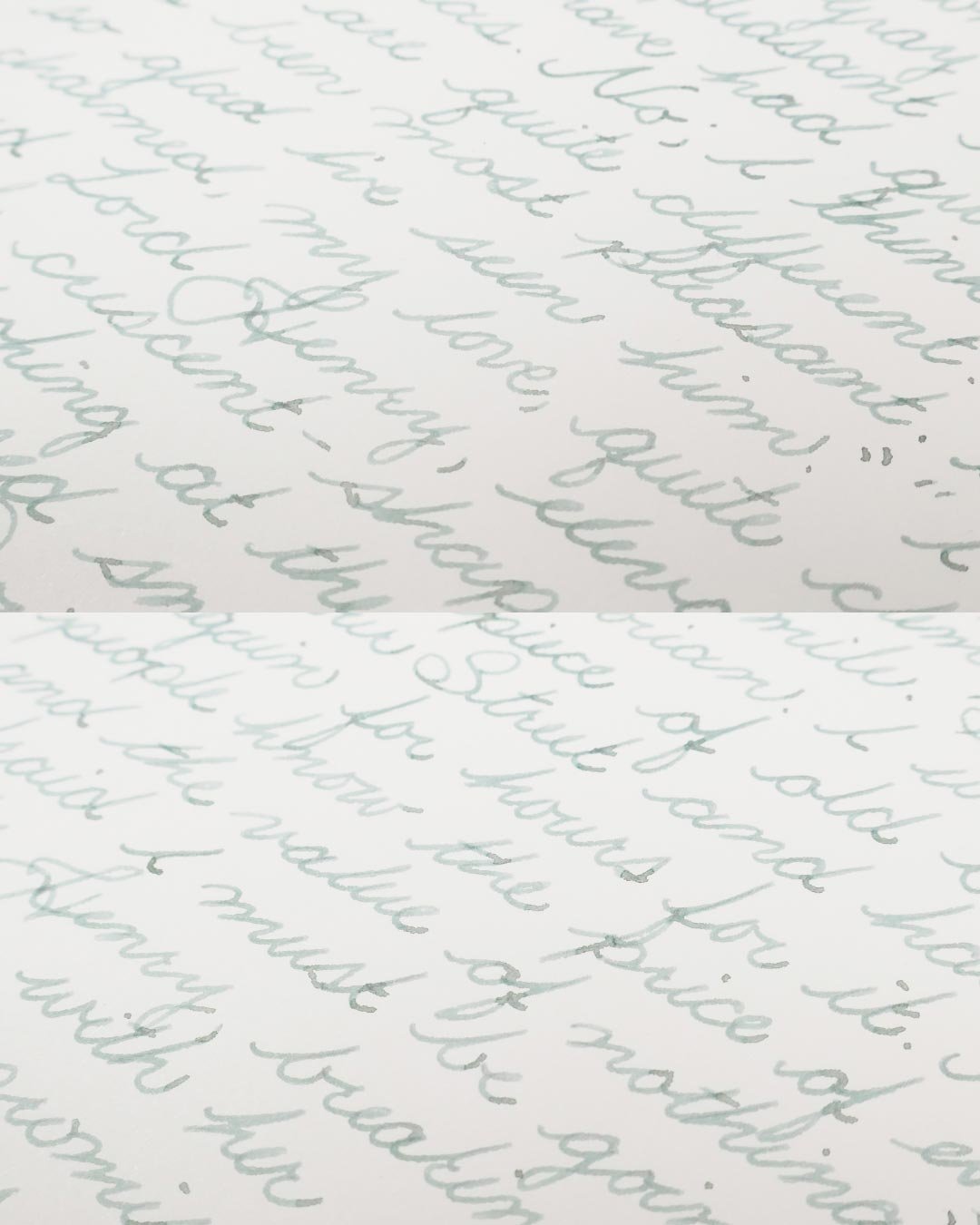Troublemaker Petrichor
Ink Review #68
*Please note that the scan is the accurate representation of this color.
Overview
The color/properties:
Troublemaker Petrichor is a multi-shading ink. It has a pale and misty grey-green base that can separate into a faded lavender tone. I put emphasis on can because, during all of my writing tests, I was never able to recreate this effect to any significant degree. Of course, that doesn’t mean it’s not possible, and you may achieve these results if you can lay enough of the ink down with a pen. Nevertheless, it still offers a high amount of shading, often with soft darker edges between its light and dark tones, and you may still notice the slightest hints of pink in areas where the ink pools the most.
Ink Splat
Ink Droplets
Rhodia
Leuchtturm1917
Performance on paper:
Petrichor shouldn’t have any issues with most fountain pen-friendly papers. There was the smallest amount of bleed-through on the Kokuyo sheet, but no noticeable feathering or bleeding on the other papers.
The dry times were excellent, with most of the nibs drying around the 10-second mark, and never extending past 15 seconds (though surprisingly, the dry times were noticeably worse on Leuchtturm).
The water resistance wasn’t great, but there were still light pink traces left behind of whatever was written that may have mixed legibility.
Midori MD
Maruman
Tomoe River
Kokuyo
Water resistance
Chromatography
Performance in the pen:
Before I got this ink, I was familiar with the many claims that it was incredibly dry (to put it nicely). Upon inking a pen, however, my initial impression was that the claims were greatly exaggerated. Sure, it had a dry flow, but it was alright. It was comfortable. Tolerable. My initial experience with the needlepoint through medium nibs on the test pen were good! Then along came the broad nib. This must have been the dryness horror I had heard about. The 1.1 stub was even worse. The dry flow might be enough to keep up with finer nibs, but once you get to broad sizes, it’s just unpleasant. Surprisingly, I never ran into a hard start, but there were skips. This ink likely won’t work well if you write quickly.
On the plus side, cleaning couldn’t have been easier. It flushed out of the pen instantly with one squeeze of a bulb syringe, and that was that.
Some light skipping at the tail of the D. This was a common experience as the flow had a hard time keeping up while writing in cursive with a broader nib.
Written on 52 gsm Tomoe River paper (white) with a Sailor Zoom nib.
Written on 52 gsm Tomoe River paper (cream) with a Sailor Zoom nib.
How petrichor looks when there’s something written on the opposite side of the page.
Performance in a pen: 7/10
Performance on paper: 9.5/10
Color saturation: 3/10
Sheening: 0/10
Shading: 7.5/10
Dry time: 9/10
Water resistance: 1/10
Ease of cleaning: 10/10
Shimmer: None
My personal thoughts...
I’m sure everyone can relate to that powerful and nostalgic sensory experience of smelling the earth after the first rain. Or perhaps you can even smell when it’s going to rain — that’s petrichor. It’s an interesting thing to name a color after, but then I don’t think it’s inappropriate. The color is fresh, but not cool. It really would be an excellent addition to a Spring color palette.
That doesn’t take away from my feelings of disappointment with this ink, however. It’s a nice color, but it’s not as multi-shading as I would have hoped for based on my swatches and ink splats, and I was really hoping that it would be. Perhaps it’s possible with additives, but otherwise, I don’t see how anyone could get those results organically. I’ve also seen some photos of this ink taking on a more deep blue/purple color. I’m not sure what that’s about, and I can only confirm that my bottle produced an ink that is more green than blue.
Written in a 52 gsm Tomoe River Notebook with a Sailor 1911S (Zoom nib)
More images/info:
Comparisons:
Tools and materials used in the writing samples:
A TWSBI Diamond 580 AL with 7 nib units including a Needlepoint grind, EF, F, M, B, 1.1mm stub, and an Architect grind. All nibs are tuned to perform at the same medium wetness.
A Rhodia No16 A5 DotPad
A Leuchtturm1917 A5 Notebook
A Midori MD A5 Notebook
A 68gsm A5 Tomoe River Notebook
A Maruman Mnemosyne A5 Spiral Notebook
A Kokuyo Campus A5 Notebook


















